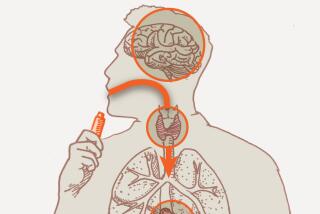Pot Users at Higher Risk for Head, Neck Cancer, Study Says
- Share via
Current and past smokers of marijuana are at increased risk of developing cancer of the head and neck, including tumors of the mouth, throat and larynx, a new study has found.
The study, the first to link marijuana with such cancers, suggests that the drug’s popularity in recent decades could have serious long-term health consequences for some users. The generation of Americans who were teenagers in the 1960s, when recreational use of marijuana became widespread, is reaching the age when many types of cancer start to become more common.
Marijuana smoke is higher in tar and carcinogens than tobacco smoke, and previous research has shown that marijuana smokers--like cigarette smokers--can develop precancerous changes in cells lining the respiratory tract. Researchers were not surprised at the news that smoking marijuana predisposes users to head and neck cancers, and they predicted it will likely be found to increase the risk of lung cancer as well.
“It’s what I expected to see,” said Li Mao, an associate professor of medicine at M.D. Anderson Cancer Center in Houston. “It appears marijuana [smoke] is a stronger carcinogen than cigarette smoke,” said Mao, who has followed research in the field.
Nevertheless, the independent effect of cigarette smoking on an individual’s cancer risk is probably greater than that of smoking marijuana, noted Eugenia Calle of the American Cancer Society, “because people just smoke so many more cigarettes.”
Cancers of the mouth, throat or larynx occur in 40,400 Americans annually and cause 12,300 deaths. Such cancers are often curable if caught early. Smoking, chewing or sniffing tobacco, and drinking alcohol are proven risk factors.
Lung cancer is the No. 1 cause of cancer mortality, striking 171,600 Americans and killing 158,900 annually. Tobacco smoking is estimated to cause 80% of all lung cancers.
Researchers decided to investigate the possible role of marijuana in head and neck cancers because marijuana smoke is high in tar and people who use the drug tend to inhale deeply, depositing four times more particulate matter in the mouth, throat and windpipe than cigarette smokers, said Zuo-Feng Zhang, an epidemiology professor at UCLA and a principal author of the new study.
For the study, performed at New York’s Memorial Sloan-Kettering Cancer Center, researchers enrolled 173 patients with head or neck cancer as well as a comparison group of 176 cancer-free blood donors of similar age and sex. Participants were questioned about their past use of marijuana, tobacco and alcohol, workplace and environmental exposure to possible carcinogens, and other aspects of their background and lifestyle. Frequency of marijuana use was categorized as never, less than or equal to once per day, and more than once per day. Duration of use was categorized as never, one to five years and more than five years.
Among those who had ever used marijuana, the risk of head and neck cancer was 2.6 times greater than among those who had never used the drug. (Researchers arrived at this figure after adjusting for the effect of other risk factors, such as smoking and alcohol.) Researchers also observed a dose-response effect of marijuana, with heavier users at higher cancer risk. Among people who reported smoking marijuana once a day, the risk of head and neck cancer was 2.1 times that of someone who never used it, while among those who reported smoking it more than once a day, the risk was 4.9 times that of those who had abstained.
People who were current smokers of both tobacco and marijuana had by far the highest risk of head and neck cancer, indicating that the two substances work together synergistically to promote cancer development. Current users of both substances had 36 times the risk of head and neck cancer found in people who used neither.
Calle, who is director of analytic epidemiology at ACS, said the new findings underscore the long-term danger of smoking marijuana and the need for research into better ways of delivering the drug’s active ingredients if it is to be used by people with chronic illnesses to relieve pain, nausea, muscle spasms and other symptoms, as some have advocated. “ACS is supportive of research into the benefits of cannabinoids [marijuana’s active ingredients],” she said, “but . . . they do not advocate the use of inhaled marijuana.”
Calle said current and former marijuana smokers may be wise to follow current ACS guidelines on head and neck cancer for tobacco smokers. The society suggests smokers look for any unusual sores, lumps or patches on lips or in the mouth, tongue, cheek or neck; ask their dentist to check the mouth and tongue closely at each visit; and consider having a doctor examine the mouth and neck area annually or twice a year.






